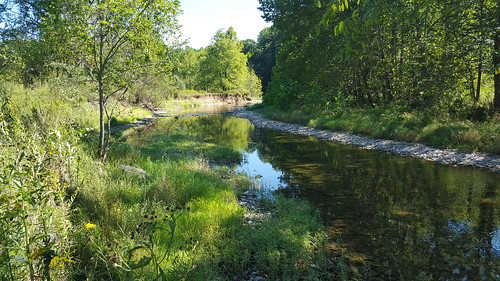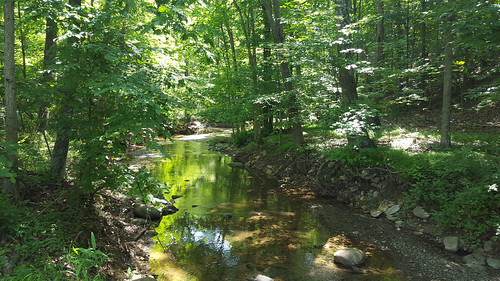Supporting Stream Communities from Bottom to Banks: Mussel and Tree Plantings Bring Healthy Waters to Town Creek
As a tree’s canopy spreads over a stream and its roots anchor into the soil, humans and wildlife alike reap the benefits. These include cleaner water through erosion and runoff control, cleaner air through leaves’ absorption of carbon dioxide and other particles, and food, shelter, and shade for all life forms.
These living, breathing filters benefit the terrestrial habitat and the aquatic habitat. One group that benefits from shady, tree-lined waterways are freshwater mussels.
Due largely to degradation and loss of stream habitat, as well as climate change, more than 70% of mussels in the U.S. are now extinct, endangered, or in decline. Of Maryland’s 16 native freshwater mussel species, 14 have been identified as species of greatest conservation need in the State Wildlife Action Plan. These species are often highly sensitive to stream temperature. The eastern elliptio, Maryland’s most common mussel species, may be found in waters averaging 64 to 77 degrees in the summer. A more rare species, the dwarf wedgemussel, is restricted to a few streams that reach summer temperatures up to a mere 73 degrees.
“The best remaining mussel populations occur in relatively intact streams in predominantly forested watersheds,” says Matthew Ashton, a Maryland Department of Natural Resources (DNR) biologist. Multiple studies have found diverse mussel populations and rare mussel species correlate with the presence of forested streamside buffers, or riparian buffers. Streams shaded with forest provide sustainable, resilient cool-water refuges that benefit mussels as well as other native species like brook trout.
Collaborating in the Town Creek Watershed
The Maryland Forest Service works with private landowners to get trees in the ground for stream restoration projects that support habitat for mussels and brook trout. These projects are often areas of collaboration with other DNR units that manage fishing, wildlife, and resource assessment. A mussel augmentation project in Allegany County’s Town Creek watershed is a great example of intra-agency collaboration.
The Maryland Forest Service has been planting riparian forest buffers in the Town Creek watershed since 1997 thanks to supportive landowners and funding from the U.S. Environmental Protection Service (EPA). Project Forester Dan Hedderick began the Town Creek Ecosystem Management Project through Special Rivers Project grant funding, eventually expanding the project to most of Allegany County. More than 100,000 linear feet and 327 acres of buffers have been put in the ground so far by forestry staff and partners. Today, streamside forests along Allegany County waterways shade the water and reduce runoff, providing the sediment-free stream bottoms and cool temperatures required by native mussel species.
Following the long-term success of the Forest Service’s riparian forest buffer project, staff from DNR’s Wildlife and Heritage Service and Resource Assessment Service have overseen the successful release of fresh-water mussels in Town Creek. Beginning in the summer of 2020, staff planted 116 hatchery-propagated brook floater mussels in stream bottoms where buffers had been established. After two months, there was zero mortality among the small mussels and they’d grown up to a tenth of an inch.
“DNR has been conducting freshwater mussel surveys and monitoring for over 30 years. There’s still much to learn,” says Wildlife and Heritage Service zoologist James McCann. Preparing for work in the Town Creek watershed began in 2015 with the revision of Maryland’s State Wildlife Action Plan, which recognized a need for mussel restoration projects.
Pilot studies to culture freshwater mussels in a DNR fish hatchery, develop a freshwater mussel restoration plan framework, and conduct an experimental reintroduction of a common species of mussel were all necessary before committing department resources to larger mussel conservation projects like the one in Town Creek. This work involved a range of partners, including Trout Unlimited, Pennsylvania Fish and Boat Commission, and the Virginia Fisheries and Aquatic Wildlife Conservation Center at Harrison Lake National Fish Hatchery.
Experimental mussel releases and monitoring will continue in Town Creek through 2023. “Ultimately, we hope to restore a healthy, self-sustaining mussel community. This will help maintain overall stream health in Town Creek and bring downstream benefits to the Potomac River, and eventually the Bay,” says McCann.
Living Filters
Freshwater mussels play important roles in their stream habitats. They are sometimes called biosentinels because their presence indicates healthy waters free of contaminants or pathogens. One adult mussel can filter an estimated 10-15 gallons of water a day, and the presence of mussels has been linked to healthy fish populations. According to EPA data, a 6-mile stretch of mussel beds can remove 25 tons of particulates per year from our waterways. With some mussels able to live more than 100 years, these ecosystem services can have enormous effects on Maryland’s waters.
Just as trees keep waters cool and clean, mussels are important to maintain healthy freshwater systems that support other species’ survival. From stream bottom to stream bank, mussel populations and the forest are living filters that can clean our environment for centuries to come.
dnr.maryland.gov/forests
Francis Smith is a Natural Resources Planner with the Maryland Forest Service. Article appears in Vol. 25, No. 2 of the Maryland Natural Resource magazine.




 1-888-373-7888
1-888-373-7888 233733
233733